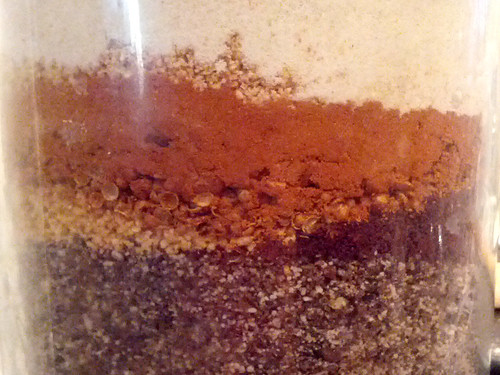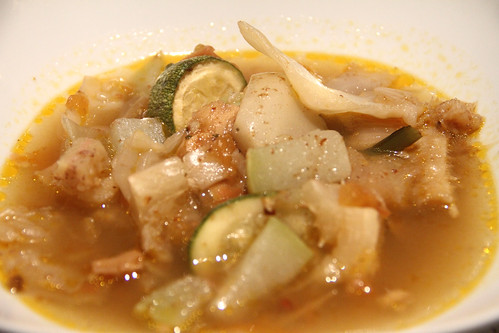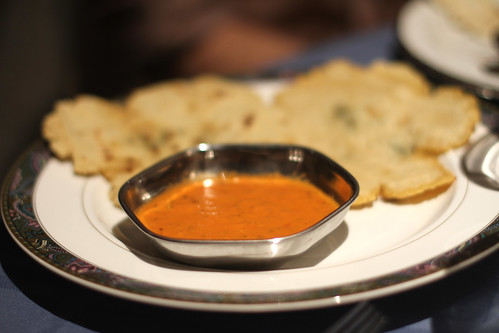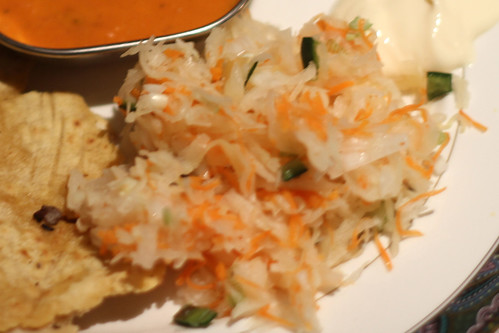After a three-week trip to India, where our senses were entranced with spices, I was afraid that Salvadorean food would prove mild and uninteresting. While it's true that pupusas are a pretty straightforward food, I was surprised by the creative combination of ingredients, such as aged cheese in dessert, cloves in a soup, and coriander seed in a drink. While the food of this small, dense, Pacific-facing nation shares most of its base ingredients with its Latin American neighbors, a few of the ingredients — namely, morro seeds and loroco flowers — are very particular. I had to ask around at about a half a dozen markets in Sunset Park before I finally was pointed to yet another market with a Mexican flag in front...that had them! The clue was that it was down the street from a Salvadorean restaurant.
Joining us for this first nosh of the year were all couples: Jessica and Alex, Kate and Jason, Michelle and JJ, and Clara and Jesse.

Horchata | Spiced grain drink | Recipe (Spanish)

You've probably encountered horchata as an opaque, milky-white, moderately gritty, cinnamony drink at a Mexican restaurant. Turns out this drink, whose name derives from the Latin word for "barley," has all sorts of variations around the Hispanic world, with pretty much the only thing in common being a starchy base with spices.
The Salvadorean variety is quite distinctive; as you can see in the above photo it has many components, all of which are toasted and ground individually. On the bottom is morro seed, which comes from a very-hard-to-crack fruit. Next come cocoa, nutmeg, peanuts, coriander seed, cinnamon, allspice, sesame seeds, and finally rice flour. This is then mixed with water, allowed to sit for a bit, and strained before sweetening, chilling and drinking.
The flavor is notably more complex and earthier than a Mexican horchata, or at least the kinds I've had; it's mostly the depth and richness from the morro seeds but you also appreciate the complex interplay of so many spices you rarely see at the same time.
Sopa de patas | Hoof and tripe stew | Recipe

I'm not quite sure what Salvadoreños do with the rest of the cow, because this stew, using some of the most humble parts of the animal, is just about the only beef-based recipe I came across. (If you're familiar with the cuisine of this part of the world, you may know this type of dish as mondongo.) As with so many dishes made of odd parts, it's a long and slow process to cook the hooves long enough that the cartilage and other stuff simply falls off the bones. Between this and the sprinkling of tripe, you don't actually end up with much protein to chew on; what really makes this soup is the rich broth and the variety of vegetables that populates it. That, and the relajo spice mix; in my homemade version, I might have used a bit too much clove and not enough of the other ingredients like chili and sesame seed, but I liked it!
Pupusas | Stuffed corn tortillas | Recipes: pupusas and pork filling

The pupusa is certainly the best known Salvadorean food in the US. It uses the same lime-treated corn that's used for tortillas, but instead of being pressed really thin, it's stuffed with a filling, pressed a little thicker, and then griddled for a few minutes. We made two types. Queso con loroco was a mix of melty and hard cheese with a particular type of edible flower bud. Chicharron, or fried pork, was made from a pork butt (aka pernil) that I cooked very slowly on the stovetop with a bit of tomato sauce (see below); when it was fork-tender I shredded it, cooked it until it started frying itself, mixed in a bit more sauce, and ran it through the meat grinder.
I wouldn't call these pupusas the most beautiful or successful thing I've every made. I probably got the water proportion in the dough wrong which led to cracking edges, and they were honestly pretty bland. Maybe I didn't use enough filling but I was already failing at keeping the filling fully inside. Hmph.
Salsa roja | Tomato sauce | Recipe

This simple tomato sauce, on the other hand, was quite tasty. I made it with summer-ripe tomatos I'd cached away in the freezer. It would have been preferable to use a food mill to make it smooth. Absent that, I used my immersion blender, which was convenient but incorporated more air and hence turned the sauce a bit more orange.
Curtido | Cabbage slaw | Recipe

This is the universal Salvadorean condiment, a simple shred of cabbage and carrots seasoned with vinegar and allowed to ferment slightly. It would probably have been rather tastier had I made some homemade pineapple vinegar as is apparently very common; as it was, my substitute attempt with apple cider vinegar fell a bit flat.
Oh, notice also the dollop of cream on that plate. Crema salvadoreña is about as thick as a soured cream could be and still be pourable, and it has a rich and almost funky culture flavor.
Quesadilla | Aged-cheese poundcake | Recipe

Quesadilla is a portmanteau, a mashup of the words queso (cheese) and tortilla. And as there are two types of tortilla — the Mexican flatbread and the Spanish baked omelette — there's a quesadilla that corresponds to each. The former is, of course, essentially the Mexican version of a grilled cheese sandwich. But the latter, which is enjoyed in El Salvador, is in fact a dessert that closely resembles a poundcake, except with cultured cream as well as an aged cheese that closely resembles parmesan in flavor. Despite its status as a dessert, it's not very sweet, and in fact the savoriness and saltiness of the cheese comes through quite clearly.
We're traveling next week, but the weekend after we're zooming to the Red Sea for Eritrean food!